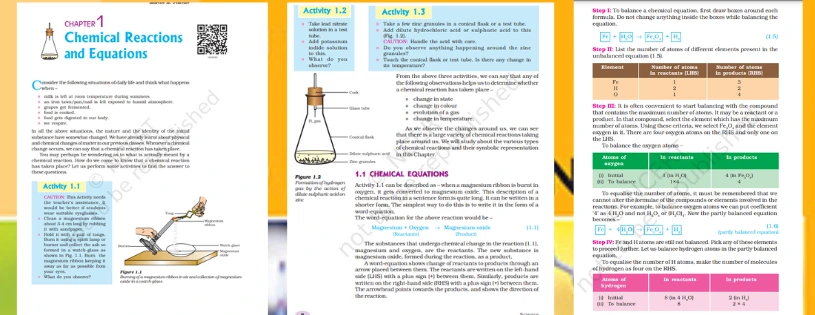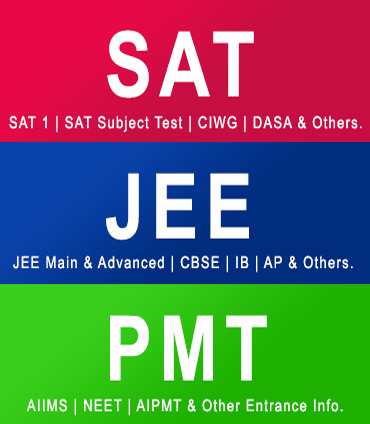CBSE Class 10 Types of Chemical Reactions & Preparation download
A chemical reaction occurs when reactants undergo a chemical reaction and change chemically to produce products. As an illustration, during respiration, oxygen is inhaled and combines with glucose to form carbon dioxide, water, and energy. The response is provided below.
C6H12O6 + 6O2 → 6CO2 + 6H2O + Energy
Qualities of a Chemical Process
One or more of the following traits can be seen in chemical reactions.And Get a detailed understanding of these attributes.
Gas evolution: The evolution of gas involves several chemical processes. Zinc, for instance, interacts with hydrochloric acid to generate zinc chloride and release hydrogen gas.
Zn + 2HCl → ZnCl2 + H2 is the reaction.
Alteration in hue: A color shift can be a sign of certain chemical processes. For instance, a yellow precipitate of lead iodide and colorless potassium nitrate is created when colorless lead nitrate combines with potassium iodide.
Pb(NO3)2 + 2KI = PbI2 + 2KNO3 is the reaction that occurs.
Variation in temperature: A temperature shift can occur during several chemical processes. As an illustration, certain processes are endothermic in nature, whereas others are exothermic.
Shift of energy: An energy change is a common part of chemical processes. In a chemical process, energy can either be absorbed or evolved. For instance, energy is released during combustion processes, such as when a fuel burns.
Precipitation formation: Precipitate formation is a side effect of several chemical processes. For instance, when barium chloride and sodium sulfate combine, sodium chloride and barium sulfate precipitate are produced.
The reaction is as follows: BaCl2 + Na2SO4 —> BaSO4 + NaCl
State shift: A change in state occurs in conjunction with several chemical processes. For instance, solid ammonium chloride crystals are created when ammonia and hydrogen chloride gasses combine.
NH3(g) + HCl(g) —-> NH4Cl(s) is the reaction.
Chemical Reaction Types
There are several kinds of chemical reactions. The eight most prevalent forms of chemical reactions are covered here, and they are also included in the chemistry curriculum for class X.
Reaction of decomposition: A decomposition reaction is the breakdown of molecules or compounds into two or more new, simpler chemicals. Take water electrolysis, for instance. Water is electrolyzed to produce hydrogen and oxygen, which have entirely different characteristics from water.
2H2O electricity → 2H2 + O2 is the reaction.
Combined response: A combination reaction is the chemical union of two or more molecules to create a new material or compound. Reactions of combination and breakdown are in opposition to one another. For instance, burning magnesium ribbon (or magnesium) produces ash that is gray-black and made of magnesium oxide.
Mg + O2 Reaction: MgO
Reaction of combustion: The combustion reaction releases energy, usually in the form of heat. It is an exothermic reaction. It is a process that normally results in the production of smoke, water, and heat when fuel and an oxidant (usually air oxygen) combine. For instance, burning methane produces water and carbon dioxide.
CH4 + 2O2 → CO2 + 2H2O is the reaction.
Reaction of neutralization: Reactions known as neutralizations occur when an acid and a base combine to produce salt and water. For instance, sodium hydroxide (base) and hydrochloric acid combine to produce sodium chloride (salt) and water.
One-time displacement response: More reactive metal displaces less reactive metal from its salt in a single displacement reaction. Reactivity series can be used to determine the results of these reactions. A series known as a "reactivity series" is made up of components grouped in decreasing order of reactivity. According to this reactivity series, the components at the top are more reactive than the ones at the bottom.
An illustration of a single displacement reaction is the reaction between potassium and magnesium chloride. Because potassium is more reactive than magnesium, it displaces magnesium from its salt in this process. The most reactive element is potassium, which is found at the top of the reactivity scale.
2K + MgCl2 → 2KCl + Mg is the reaction.
Reaction of double displacement: Double displacement reactions create two new compounds by exchanging the ions (usually cations) of two aqueous ionic compounds. For instance, potassium nitrate and aluminum chloride combine to generate potassium chloride and aluminum nitrate.
Precipitation Reaction: An insoluble precipitate is produced during these reactions. Precipitation reactions involve the combination of two soluble salts in aqueous solutions to generate an insoluble precipitate.
AgNO3(aq) + KCl(aq) Reaction: AgCl + KNO3(aq) ←️
Redox Reaction: Redox reactions are chemical processes in which oxidation and reduction occur at the same time. Reduction is the addition of hydrogen (or removal of oxygen), whereas oxidation is the addition of oxygen. Oxidation and reduction have previously been covered in a different article titled "Oxidation and Reduction." For a thorough explanation of oxidation and reduction, see this article.

List of Common Chemical Reactions
We are giving here a general list of common chemical reactions.
CBSE Class 10 NCERT Science Topics for a Strong Foundation
| Chapter Name | Chemical Reactions and Equations |
| Topic Number | Topic |
| 1.1 | Chemical Equation |
| 1.2 | Balanced Chemical Equation |
| 1.3 | Implication of a Balanced Chemical Equation |
| 1.4 | Types of Chemical Reactions |
List of CBSE Class 10 Science Chapter
| Chapter Number | Chapter Name |
| Chapter 1 | Chemical Reactions and Equations |
| Chapter 2 | Acids, Bases and Salts |
| Chapter 3 | Metals and Non-metals |
| Chapter 4 | Carbon and its Compounds |
| Chapter 5 | Life Processes |
| Chapter 6 | Control and Coordination |
| Chapter 7 | How do Organisms Reproduce? |
| Chapter 8 | Heredity |
| Chapter 9 | Light – Reflection and Refraction |
| Chapter 10 | The Human Eye and the Colourful World |
| Chapter 11 | Electricity |
| Chapter 12 | Magnetic Effects of Electric Current |
| Chapter 13 | Our Environment |
List of CBSE Class 10 Mathmetics Chapter
| Chapter Number | Chapter Name |
| Chapter 1 | Real Numbers |
| Chapter 2 | Polynomials |
| Chapter 3 | Pair of Linear Equations in Two Variables |
| Chapter 4 | Quadratic Equations |
| Chapter 5 | Arithmetic Progressions |
| Chapter 6 | Triangles |
| Chapter 7 | Coordinate Geometry |
| Chapter 8 | Introduction to Trigonometry |
| Chapter 9 | Some Applications of Trigonometry |
| Chapter 10 | Circles |
| Chapter 11 | Areas Related to Circles |
| Chapter 12 | Surface Areas and Volumes |
| Chapter 13 | Statistics |
| Chapter14 | Probability |
FAQs
Que1: What is a Chemical Reaction?
Ans : A chemical reaction is the rearranging of atoms through the breaking and building of chemical bonds in one or more substances (reactants) to produce one or more distinct substances (products). Usually, this transition results in new chemical characteristics as well as energy changes.
Que2: What is a combustion chemical reaction?
Ans : When a material combines quickly with oxygen gas, it produces new chemical compounds like carbon dioxide and water as well as heat and light. This sort of chemical reaction is known as a combustion reaction.
Que3: What is a decomposition reaction?
Ans : A chemical process known as a decomposition reaction occurs when a single component splits into two or more simpler compounds.
Que 4: What is precipitation or a double displacement reaction?
Ans : When two ionic compounds in a solution exchange ions to create two new compounds, one of which is insoluble and precipitates out of solution, this process is known as precipitation or a double displacement reaction.
Que5: What is a synthesis reaction?
Ans : A chemical process in which two or more components combine to generate a single, more complex result is known as a synthesis reaction.


.webp)

